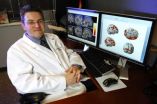(Press-News.org) PHILADELPHIA — Biophysicists at the University of Pennsylvania have helped develop a new technique for studying how proteins respond to physical stress and have applied it to better understand the stability-granting structures in normal and mutated red blood cells.
The research was conducted by Dennis Discher and Christine Krieger in the Molecular and Cell Biophysics Lab in Penn's School of Engineering and Applied Science, along with researchers from the New York Blood Center and the Wistar Institute.
Discher's research was published online in the journal Proceedings of the National Academy of Sciences.
In stark contrast with much of the architecture people interact with every day, the internal architecture of the human body is predominantly soft. Other than bones, all of the organs, tissues and structures in the body are pliable and flexible and need to be that way in order to work.
The Discher lab's research aims to understand what keeps these flexible structures stable, especially when they are under constant physical stress. Discher selected red blood cells as a model for this stress, as they make a complete lap of the turbulent circulatory system every few minutes but survive for months.
"Red blood cells are disks, and they have proteins right below the membrane that give it resilience, like a car tire," Discher said. "The cells are filled with hemoglobin like the tires are filled with air, but where the rubber meets the road is the exterior."
To measure stress in that membrane on an atomic level, the Discher team needed a way to track changes to the shape of those supporting proteins. They found an ideal proxy for that stress in the amino acid cysteine.
Proteins are long chain of amino acids that are tightly folded in on themselves. The order and chemical properties of the acids determine the locations of the folds, which in turn determine the function of the protein. Cysteine is "hydrophobic"; it interacts poorly with water and so it is usually on the inside of a protein. And because stress changes the shape of these folded proteins, Discher reasoned that measuring the degree to which cysteine is exposed would in effect measure how stressed the protein and cells containing it are.
Discher's team simulated the shear forces originating from the beating heart, which forcefully pumps blood and ultimately pulls apart the folds that keep cysteine on the inside of proteins at the red blood cell membrane, allowing it to bind with a fluorescent marker dye. The team could visually confirm that more stressed cells were more fluorescent under the microscope but actually tested the levels of marked cysteine using mass spectrometry.
"Just like a polymer engineer designing a tire, we're looking at the relationship between the chemical makeup and the physical stability of the structure and how it performs," Discher said. "We can use this technique to look at the relationship between structure, flexibility and function."
Investigating the structural elements of blood cells could pave the way to breakthroughs for human health.
"How long can blood be stored? Why are there no good blood substitutes? There are a lot of things we don't understand about the forces cells can sustain before fragmenting and falling apart, especially when we consider age and mutations," he said.
The Discher team studied the mutated blood cells that result in disorders known as elliptocytosis; cells are elliptical, rather than round, and therefore have shorter functional lifespans. These elliptical cells are often missing a chemical "rivet" that anchors the support proteins to the outer membrane, which means that stress causes them to "disassociate," or disconnect, rather than unfold.
That kind of structural change is crippling to the function of anatomical structures like blood cells. The flexibility provided by unfolding is therefore key to their overall stability.
"At least for this cell, the first mechanism of response is to unfold proteins and keep the interactions between proteins the same," Discher said. "That constant back and forth with unfolding within these cells as the cells flow and distort while in the blood stream, allows their architecture to be maintained."
Discher and his colleagues plan to use their cysteine-mass-spectometry technique to investigate the role of softness and flexibility in responding to stress in other biological systems, particularly stem cells, and to better understand why those traits are intrinsic to life on this planet.
INFORMATION:
Along with Discher and Krieger, the research was conducted by Xiuli An and Narla Mohandas of the New York Blood Center and Hsin-Yao Tang and David W. Speicher of the Wistar Institute.
The research was supported by the National Institutes of Health.
END
HOUSTON -- (May 3, 2011) -- A Rice University-led team of physicists this week offered up one of the first theoretical explanations of how two dissimilar types of high-temperature superconductors behave in similar ways.
The research appears online this week in the journal Physical Review Letters. It describes how the magnetic properties of electrons in two dissimilar families of iron-based materials called "pnictides" (pronounced: NICK-tides) could give rise to superconductivity. One of the parent families of pnictides is a metal and was discovered in 2008; the other ...
CAMBRIDGE, Mass. -- MIT chemical engineers have designed a new type of drug-delivery nanoparticle that exploits a trait shared by almost all tumors: They are more acidic than healthy tissues.
Such particles could target nearly any type of tumor, and can be designed to carry virtually any type of drug, says Paula Hammond, a member of the David H. Koch Institute for Integrative Cancer Research at MIT and senior author of a paper describing the particles in the journal ACS Nano.
Like most other drug-delivering nanoparticles, the new MIT particles are cloaked in a polymer ...
Ecstasy – the illegal "rave" drug that produces feelings of euphoria and emotional warmth – has been in the news recently as a potential therapeutic. Clinical trials are testing Ecstasy in the treatment of post-traumatic stress disorder.
But headlines like one in Time magazine's health section in February – "Ecstasy as therapy: have some of its negative effects been overblown?" – concern Ronald Cowan, M.D., Ph.D., associate professor of Psychiatry.
His team reports in the May issue of Neuropsychopharmacology that recreational Ecstasy use is associated with a chronic ...
Boston, MA – A common component in webcams may help drug makers and prescribers address a common side-effect of drugs called cardiotoxicity, an unhealthy change in the way the heart beats. Researchers at Brigham and Women's Hospital (BWH) have used the basic webcam technology to create a tool to look at the effects of medications in real time on heart cells, called cardiomyocytes. These findings were published in the journal, Lab on a Chip on April 11, 2011.
Researchers developed a cost-effective, portable cell-based biosensor for real time cardiotoxicity detection using ...
An ancient, bipedal hominid needs a new nickname. Paranthropus boisei, a 2.3 million to 1.2 million-year-old primate, whom researchers say is an early human cousin, probably didn't crack nuts at all as his common handle suggests.
"Nutcracker Man" most likely ate grass and possibly sedges, said geochemist Thure Cerling, lead author of a study published in the May 2 online edition of the journal Proceedings of the National Academy of Sciences.
Cerling and colleagues determined P. boisei's diet by analyzing carbon isotope ratios in the tooth enamel of 24 teeth from 22 ...
WALNUT CREEK, Calif.—Fungi play significant ecological and economic roles. They can break down organic matter, cause devastating agricultural blights, enter into symbiotic relationships to protect and nourish plants, or offer a tasty repast. For industrial applications, fungi provide a source of enzymes to catalyze such processes as generating biofuels from plant biomass. One large fungal group with such enzymes are the rust plant pathogens which cannot survive on their own so they use crops as hosts, leading to reduced yields and potentially hindering efforts to grow biomass ...
Durham, NC – Most of us wouldn't consider slow-moving snails to be high-metabolism creatures. But at one point in the distant past, snail metabolism sped up, says a new study of marine snails in the journal Paleobiology.
"Many of the marine snails we recognize today — such as abalone, conchs, periwinkles and whelks — require more than twice as much energy to survive as their ancestors did," said co-author Seth Finnegan of the California Institute of Technology.
The findings come from a new analysis of snail fossils formed one to two hundred million years ago, during ...
LOS ANGELES, May 3, 2011 – When it comes to healthy snacking and weight management, a new study bolsters the long-held view that not all calories are created equal. According to nutrition researchers at UCLA, choosing to snack on pistachios rather than pretzels as part of a healthy diet not only supports your body mass index (BMI) goals, but can support heart health too.
The study, recently published in the Journal of the American College of Nutrition is especially significant in today's diet as snack foods account for more than a quarter of the total caloric intake ...
Rutgers researchers have developed an innovative new treatment that could help minimize nerve damage in spinal cord injuries, promote tissue healing and minimize pain.
After a spinal cord injury there is an increased production of a protein (RhoA) that blocks regeneration of nerve cells that carry signals along the spinal cord and prevents the injured tissue from healing.
Scientists at the W.M. Keck Center for Collaborative Neuroscience and Quark Pharmaceuticals Inc. have developed a chemically synthesized siRNA molecule that decreases the production of the RhoA protein ...
New Rochelle, NY, May 3, 2011—Researchers at last month's AACR conference in Orlando demonstrated that they are intensifying their efforts to identify and validate various types of biomarkers that are detectable in readily accessible bodily fluids such as blood and urine, reports Genetic Engineering & Biotechnology News (GEN). The goal is to detect biosignatures that are more specific and sensitive than existing diagnostic modalities, according to the May 1 issue of GEN (http://www.genengnews.com/gen-articles/cancer-detection-improved-with-noninvasive-testing/3639/).
"The ...



